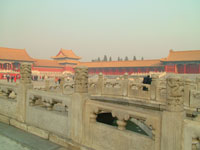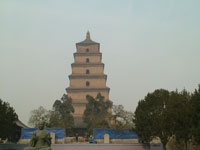Famous Ancient Chinese Buildings
Imperial Palace
 In order to consolidate the emperors' control, highlight the dignity of the imperial power, and satisfy their extravagant material lives, grand palaces were always built in large scale. For thousands of years, successive emperors spare no labor, material or money to build majestic palaces for them. Those solemn and magnificent palaces fully exhibit the wisdom and creative power of the Chinese people.
In order to consolidate the emperors' control, highlight the dignity of the imperial power, and satisfy their extravagant material lives, grand palaces were always built in large scale. For thousands of years, successive emperors spare no labor, material or money to build majestic palaces for them. Those solemn and magnificent palaces fully exhibit the wisdom and creative power of the Chinese people.
- Beijing Imperial Palace: The Forbidden City
- Shenyang Imperial Palace: The palace was used by the Qing rulers before they removed their capital to Beijing. The Shenyang Imperial Palace covers an area of more than 60,000 square meters. There are totally more than 20 courtyards and 300 rooms.
Altars and Temples
Altars and temples occupy an important place in ancient Chinese Architecture. They are ceremonial sites between religious and non-religious buildings and are served for offer sacrifices to the heaven, the earth, the sun, the moon, the country, mountains, emperor and scholars of the past, as well as ancestors.
Temple of Heaven: The temple was where the Emperor came every winter solstice to worship heaven and to solemnly pray for a good harvest.
Mausoleums
Mausoleums make a very important part in ancient Chinese architectures. In ancient times, people in China believe that the sprit dose not die with the body. They attached importance to the funeral so much that every class of the society designed the mausoleums elaborately. In the long history, Chinese mausoleum buildings have well developed. The large scales of kings’ and queens' mausoleums are rarely seen in the world. The mausoleums are integrated with various arts, such as painting, calligraphy, carving and so on. Therefore, mausoleum architecture is a synthesis of achievements in many artistic fields. The overall arrangements of Chinese mausoleums always include walls around, doors opened to four directions, as well as turrets on four corners.
Mausoleums are the most majestic and also the biggest building complexes in ancient China. These mausoleums are always built back on the mountains; some of them are also on the plains. There is usually a paved path leading to the tomb with stone persons and stone beast on both sides. Many trees, usually pines and cypresses, are planted around the mausoleums, which add to the atmosphere of solemn, respectful and quiet.
City Walls
Ancient Chinese cities often circled by two huge walls. The inner wall is called " cheng", while the outer wall is called " guo". " Cheng Guo" is used to refer to the ancient city walls.
There are also moats surrounding the walls. In the past times, the moat was called " chi", and the inner city was called " geng". The city wall and the moat are called " cheng chi" as a whole. The ancient cities had an integrated architectural system, for example, there are 2 to 3 gates to the city. (Big cities usually have more gates. The Beijing inner city has 9 gates in the Ming and Qing Dynasties). There is always a tower over the city gate. The number of the tower is always the same as that of the gate. There are also four watchtowers at each corner of the city wall. In order to reinforce the city wall, a section of the city wall, also known as " ma mian" is projected to the outside in every certain distance. In the inner side of the city wall, cavalries with their horses can climb up the wall by the horse path.
Nanjing City Wall was built during the Ming Dynasty. The wall is 14 meters wide at the base and it's 14-21 meters tall. There are 13,616 crenels, 200 sheds, 13 gates on the wall, among which the most spectacular gates are Jubao Gate, Sanshan Gate and Tongji Gate. The solid wall was made of huge stones as the base and huge bricks.
Pagodas
 As a kind of unique architecture rooted in India, pagodas in China were constructed since the Buddhism was introduced to China. The pagodas, generally known as the carrier of Buddhism culture, found its integration in the traditional Chinese architecture and the design was greatly changed. The nationalization of Indian pagoda demonstrates the good virtues of the
As a kind of unique architecture rooted in India, pagodas in China were constructed since the Buddhism was introduced to China. The pagodas, generally known as the carrier of Buddhism culture, found its integration in the traditional Chinese architecture and the design was greatly changed. The nationalization of Indian pagoda demonstrates the good virtues of the